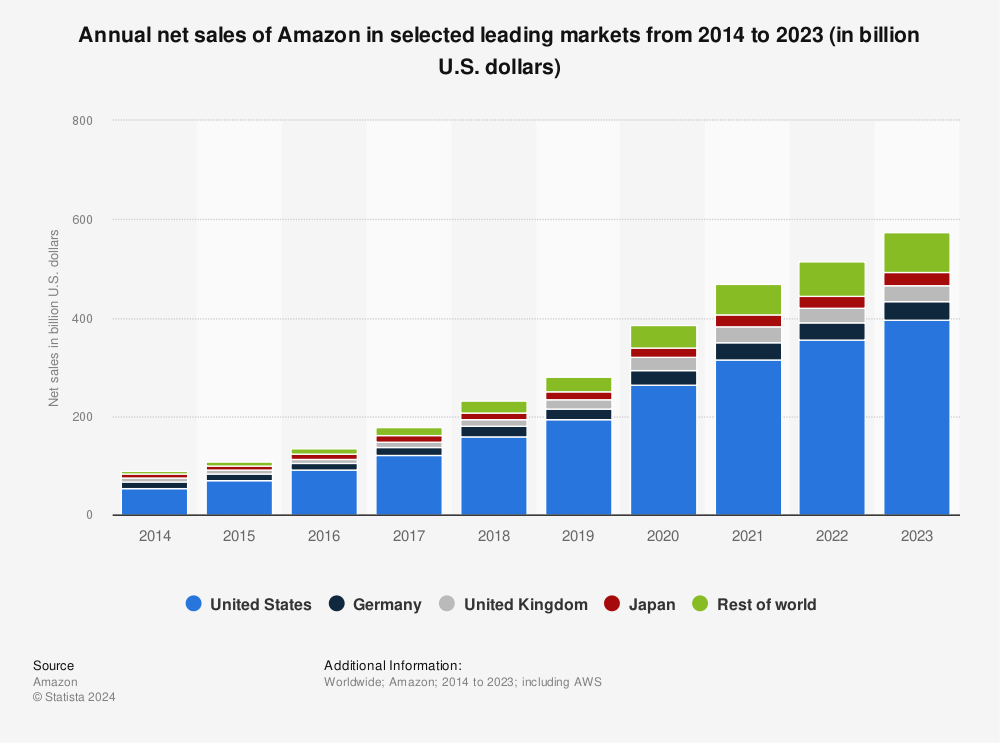So you’ve been selling on Amazon for a little while now. You know the ropes, launched a product or two and revenues are steady. You’ve got grand ambitions, but you’re unsure exactly how to take it further.
Lots of FBA sellers find themselves in this position. They’ve had a taste of success and they’re ready to double down and scale their businesses to the next level. They question how this can be done without increasing their workload. In fact, most want to grow their business while phasing themselves out of the grunt work.
In reality, scaling an Amazon FBA business can be more straight-forward and less work than it seems. If you’re smart you can leverage your existing assets, experience and customer base to increase your revenue.
Looking for inspiration for adding digits to your monthly Amazon income? Here are 6 ways to transform a humble FBA operation into an e-commerce empire.
How to grow your Amazon business
Here’s a list of the top 6 ways to grow an Amazon business. These are tried and tested methods that sellers are using today that have had an exponentially positive impact on their revenue and profits. Ultimately it comes down to you to make the final decision, and you could choose to use one or more of these scaling tactics listed below.
1. Launch More Products

You’re already selling in a particular category and niche, so you’ll have gained a fair understanding of your customers. So why not continue to build your brand to cater to them more?
Additional products should be selected carefully. Looking for products your existing customers are also interested in. It’s easy to start your research on Amazon by looking at:
- Sub categories within your current main category
- “Sponsored products related to this item” from product listings
- “Customers who bought this item also bought” from product listings
- Your competitor’s Amazon Store
The next step of the process is looking at supply and demand. Pick out products with great potential for boosting your revenue. Consider higher value products, higher margin products or low margin high volume products.
When it comes to sourcing, go the extra mile to source high-quality products. Visiting Canton Fair is a great way to discover new products, experience them first hand and establish relationships with suppliers.
Launch in existing categories:
The benefits of launching new products in the same category of niche as the one you are already successful in is that it usually makes for less product research to build out your listing, and if you have a trademark and are in the brand registry, you can often use the same trademark as it’s in the same category.
Finding new categories:
However, it’s also a solid approach to launch products in entirely new categories. This way, you are being less prescriptive, and therefore more likely to find the best opportunities with high demand and low competition.
JungleScout’s Web App makes it easy to find products selling like hot cakes and estimate profitability. Use the smart filters to find products in a range of product categories that have the highest demand and lowest barrier to entry.
2. Add Product Variants using Child ASINs

Perhaps you didn’t consider this one, but it can be an easy way to increase revenue. Instead of launching similar products under a completely different listing, why not piggyback off your established ones?
Launching a new product under a new listing takes time. You’ll need to gather reviews and drive sales to climb up the ranking. But if you add a child ASIN to a high performing listing, you’ll get a chance to get exposure from the get-go.
Here are some ideas of how you might leverage child ASINs to drive more revenue:
- Larger or smaller sizes
- Different colors or designs
- Multipacks
- Cross-sell similar products and variants
However, if you wish to rank for different keywords or take up more real-estate space on search results, you might consider a separate listing. Just be sure you have a good launch strategy in place to gain momentum!
The Jungle Scout Million Dollar Case Study used this strategy, and launched several variants of the publicly launched Baby Hooded Towel. We discovered designs and colors that sold well for competitors and added similar variants using our existing supplier.
3. Expand into More Amazon Markets

While Amazon US leads for net sales, expanding into the other leading markets is still very worthwhile. Amazon is even willing to assist you with shipping existing stock to their international warehouses.
Germany, United Kingdom and Japan markets can provide great additional streams of revenue. These markets have varying levels of supply and demand, customer demographics and competitors of course. You’ll need to research each market to find the best opportunity for your brand in different regions.
Amazon Global Selling explains more about how to expand into new markets:
Also, check out this Million Dollar Case Study Europe edition, for a full step-by-step view of expanding into the European market for inspiration.
4. Optimize Existing Amazon Product Listings

It makes perfect sense to maximize your existing assets before expanding into new territory. Besides, optimizing your product listing will have a powerful effect on ranking, exposure, click-through-rates, conversion and resulting revenue.
Working on improving your Amazon SEO could greatly increase your exposure and attract more customers.
There’s a whole bunch of factors that can be tweaked to optimize your Amazon listing.
- Title
- Descriptions
- Features
- Images
- Pricing
- Backend Keywords
But the biggest issue is being able to track these changes and tie them to increased profitability.
That’s why we use split-testing, so we can confidently make changes based on clear evidence. Being able to measure the impact on sales and ranking enables you to continually optimize Amazon listings. Read more about split-testing amazon listings for profitability.
On top of that, optimizing your pricing is usually the single most impactful thing you can do to move the needle. As a private label seller, you are not able to use the countless “repricer” tools out there, which are designed to help Wholesale sellers who are competing for the buy box. This is why Profit Peak was created at our sister software, Splitly. This tool harnesses machine learning to give private label sellers the power to keep their pricing optimized at all times for higher profits.
5. Branch Off From Amazon – Go Multi-Channel

The biggest benefit of selling on Amazon is leveraging their massively popular marketplace, getting your product in front of hundreds of hungry shoppers every day.
It’s a great place to launch products and make impressive revenue. But let’s not forget the fact, Amazon is only a single channel. If you’re looking to build a well-rounded, more secure business, you’ll need to be able to stand on your own two feet too.
If you’re interested in diversifying by growing outside of Amazon too, here are some ideas for getting started:
- Set up your own e-commerce website using Shopify or WordPress
- Work on SEO (for Google instead of Amazon) and generating your own organic traffic
- Run paid advertisements to your website using Google AdWords or Facebook Ads
- Set up affiliate deals and promote other products alongside yours
- Leverage influencers to increase traffic and exposure for your products
Or if you would like to jump on another existing marketplace, considering looking into the following:
- eBay
- Etsy
- Jet
- Walmart
- Rakuten
Amazon is by far the largest Marketplace, with the most opportunity to scale and run a hands-off business through the use of their fulfillment service. Additionally, with the biggest audience of ready-to-buy shoppers, it’s the lowest barrier to entry when it comes to marketing. But some business owners still want to diversify and sell their products on multiple channels.
6. Combine Business Models
Rather than growing vertically, why not try expanding horizontally too. Incorporating multiple business models is a great way to leverage your existing assets and strengthen revenue.
As an FBA seller, it’s more than likely your following the Private Label business model. But your business as a whole can grow to become so much more. Here are a few ideas of how different business models can be used to grow your brand:
- Establish wholesale agreements with retailers or brick-and-mortar businesses
- Become an Amazon affiliate and promote additional products on your website to increase revenue
- Become a supplier for dropshippers by offering wholesale pricing
- Offer sale commissions to affiliate marketing networks and have them promote your products
Common FBA Business Scaling Difficulties
Why can’t you start scaling your Amazon business today? We’ve addressed a number of the most common difficulties faced by FBA sellers:
1. It Requires Too Much Investment

Is raising capital holding you back from launching new products or expanding into new markets? Check out these simple solutions:
- UpFund provides inventory financing for Amazon sellers looking to grow. They offer low, flat-rate fees compared to an APR based loans. Plus you’ll start paying back as you sell your inventory.
- Kickstarter is a crowdfunding platform that’s helped thousands of new ideas and innovative products get off the ground. Amazon now has their own section for successful Kickstarter Products now available on Amazon.
- Indiegogo is another crowdfunding platform that’s well worth checking out.
2. It Involves Too Much Work

If you still haven’t hired VAs or built a team yet, now is the time to do it. Scaling your business doesn’t need to require as much extra work if you leverage skilled professionals and freelancers.
Think of the most time-consuming tasks. Can they be automated? Is there software that can help or could it be outsourced to a professional? The following ideas are only scratching the surface:
- Virtual Assistants – Data Entry, Customer Service, Outreach, Admin Tasks
- Professional Freelancers – Marketing Campaigns, Website Development, Copywriting, Blogging, Social Media Advertising, Project Management
- Software – Automated Email Campaigns (JumpSend), Amazon Product Split Testing (Splitly), Accounting (Fetcher!), Amazon Market Research (JungleScout)
Looking for Freelancers? Get on the list for the beta launch of the Jungle Market!
3. Not Sure Where to Start

If you’re still not sure, a great place to start is by using our profit analytics tool, Fetcher. As well as taking care of your accounting it can really help you gain a better understanding of your business.
Laying out your financial data in a meaningful way makes it much easier to see where costs, or to identify opportunities for growth.
Start Scaling Your Amazon FBA Business Today
So here you have it, numerous ways to scale your existing business, plus solutions to common problems. So what are you waiting for?
We recommend choosing a single strategy that makes the most sense for your business. Focus on one at a time before trying to conquer the next horizon.
If you’ve got any ideas to add or experiences scaling your FBA businesses, we’d love to hear from you in the comments below.

 No Comments
No Comments